Financial Accounting Project: Sole Trader and Limited Companies
VerifiedAdded on 2020/10/22
|17
|1746
|80
Project
AI Summary
This project report delves into the core concepts of financial accounting, beginning with the double-entry bookkeeping system and its application in recording business transactions through journals and ledgers. It then proceeds to the preparation of a trial balance, ensuring the accuracy of recorded financial data. The project further explores the formulation of final accounts, including profit and loss accounts and balance sheets, crucial for assessing an organization's financial performance. The report contrasts financial statement preparation for sole traders and limited companies, highlighting the differences in accounting practices. It concludes by emphasizing the importance of accurate financial record-keeping for all types of businesses, providing a comprehensive overview of fundamental accounting principles and their practical application in financial statement analysis.
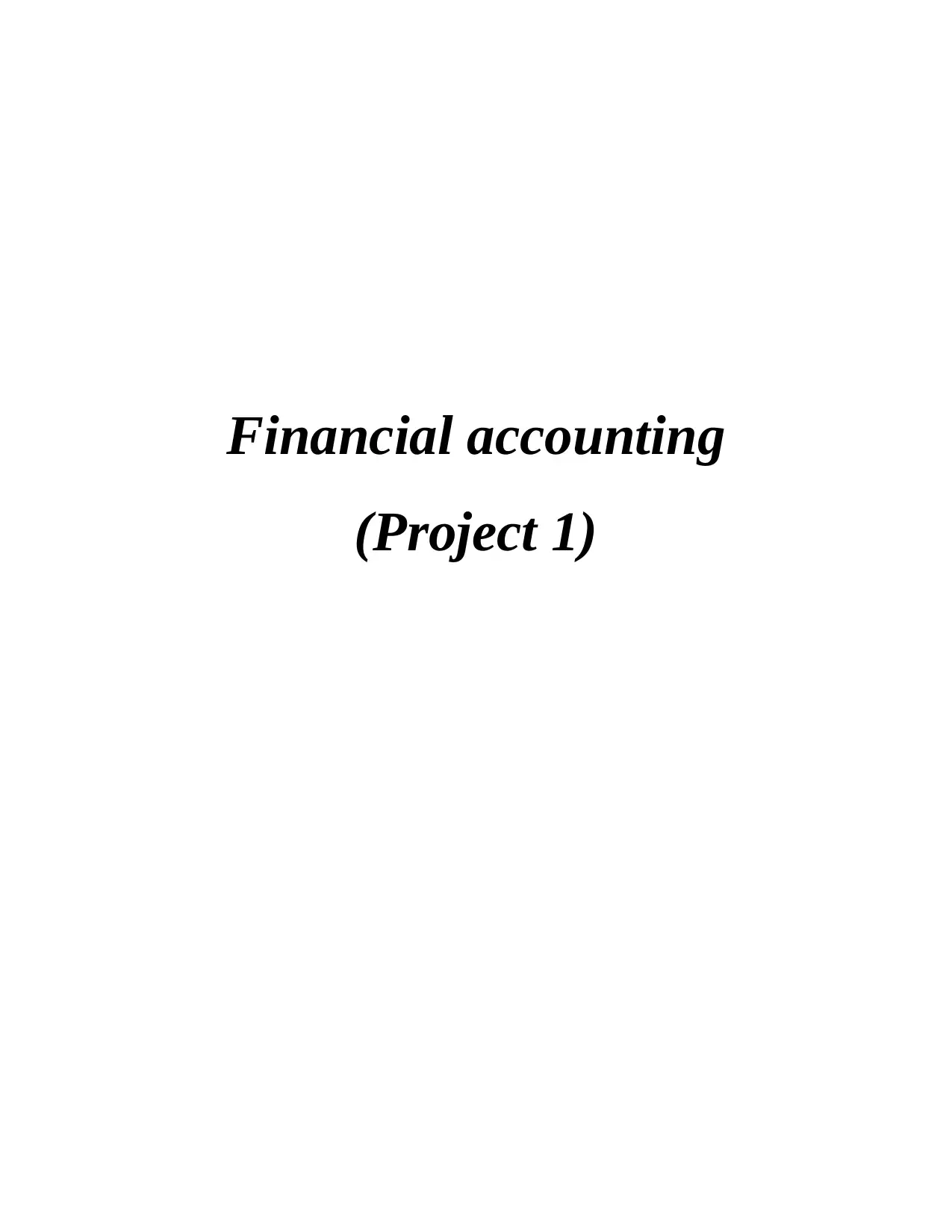
Financial accounting
(Project 1)
(Project 1)
Paraphrase This Document
Need a fresh take? Get an instant paraphrase of this document with our AI Paraphraser
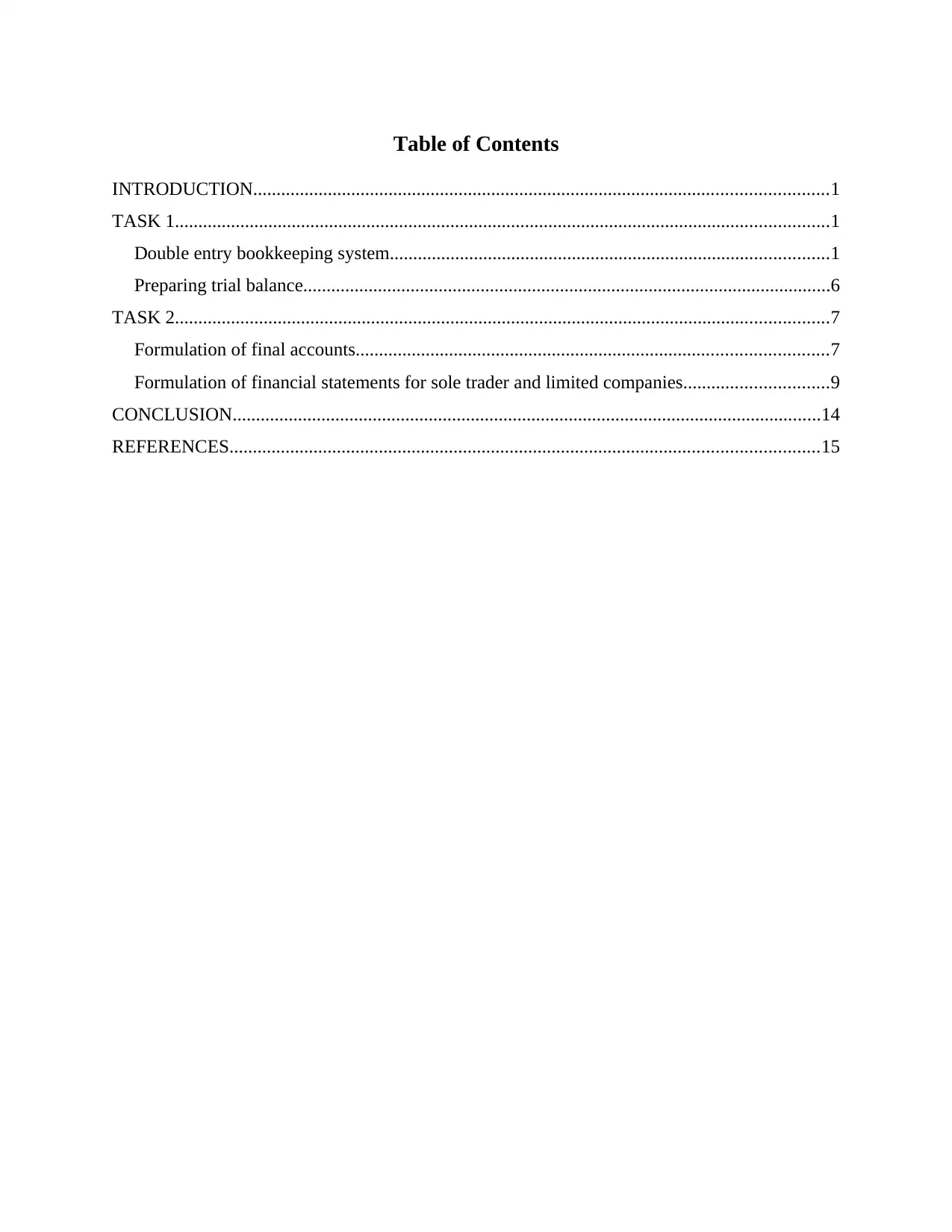
Table of Contents
INTRODUCTION...........................................................................................................................1
TASK 1............................................................................................................................................1
Double entry bookkeeping system..............................................................................................1
Preparing trial balance.................................................................................................................6
TASK 2............................................................................................................................................7
Formulation of final accounts.....................................................................................................7
Formulation of financial statements for sole trader and limited companies...............................9
CONCLUSION..............................................................................................................................14
REFERENCES..............................................................................................................................15
INTRODUCTION...........................................................................................................................1
TASK 1............................................................................................................................................1
Double entry bookkeeping system..............................................................................................1
Preparing trial balance.................................................................................................................6
TASK 2............................................................................................................................................7
Formulation of final accounts.....................................................................................................7
Formulation of financial statements for sole trader and limited companies...............................9
CONCLUSION..............................................................................................................................14
REFERENCES..............................................................................................................................15

INTRODUCTION
Finance can be defined as the element which is required to operate a business
successfully. If the organisations are not having sufficient financial resources than it can affect
their profitability and productivity. For all the accountants of a company it is very important to
record financial information appropriately so that organisation's actual financial status can be
determined by all its stakeholders (Hodder, Hopkins and Schipper, 2014). In financial accounting
different types of accounts and statements are generated by the accounts department of an
organisation. It includes formulation of journals, creation of ledger accounts, forming profits and
and loss accounts and balance sheet. For all the companies it is very important to conduct
financial accounting so that company's actual position can be determined. In this project a junior
accountant of a small accountancy firm is going to perform various tasks that includes
preparation of primary books, general ledger accounts etc. Apart from this various types of
financial statements are also going to be discussed under this report.
TASK 1
Double entry bookkeeping system
Double entry system: In this bookkeeping system all the business transactions are
related to two different accounts and also recorded in two accounts. For all the business entities,
it is very important to keep appropriate accounts so that it can help to analyse that organisation is
generating profits or bearing losses. All the transactions that are done in a specific time period
are recorded in the accounts that are generated in the same accounting period. All types of
proceedings that are made by a company will affect two different accounts and a single error can
affect all the recorded information (Nobes, 2014). Hence it is very important to record each
transaction carefully so that actual financial strength of the company can be examined. In double
entry system four different types of stages are followed by every accounts in which firstly
journals are prepared and than ledger accounts are created on the basis of journals. All the
closing balance of ledger accounts are transferred in trial balance and than final accounts are
formulated on the basis of trial balance.
If accountants of a company fails to follow all the steps than it can affect the accuracy of
all the accounts and stakeholders wont be able to analyse actual position of that organisation.
1
Finance can be defined as the element which is required to operate a business
successfully. If the organisations are not having sufficient financial resources than it can affect
their profitability and productivity. For all the accountants of a company it is very important to
record financial information appropriately so that organisation's actual financial status can be
determined by all its stakeholders (Hodder, Hopkins and Schipper, 2014). In financial accounting
different types of accounts and statements are generated by the accounts department of an
organisation. It includes formulation of journals, creation of ledger accounts, forming profits and
and loss accounts and balance sheet. For all the companies it is very important to conduct
financial accounting so that company's actual position can be determined. In this project a junior
accountant of a small accountancy firm is going to perform various tasks that includes
preparation of primary books, general ledger accounts etc. Apart from this various types of
financial statements are also going to be discussed under this report.
TASK 1
Double entry bookkeeping system
Double entry system: In this bookkeeping system all the business transactions are
related to two different accounts and also recorded in two accounts. For all the business entities,
it is very important to keep appropriate accounts so that it can help to analyse that organisation is
generating profits or bearing losses. All the transactions that are done in a specific time period
are recorded in the accounts that are generated in the same accounting period. All types of
proceedings that are made by a company will affect two different accounts and a single error can
affect all the recorded information (Nobes, 2014). Hence it is very important to record each
transaction carefully so that actual financial strength of the company can be examined. In double
entry system four different types of stages are followed by every accounts in which firstly
journals are prepared and than ledger accounts are created on the basis of journals. All the
closing balance of ledger accounts are transferred in trial balance and than final accounts are
formulated on the basis of trial balance.
If accountants of a company fails to follow all the steps than it can affect the accuracy of
all the accounts and stakeholders wont be able to analyse actual position of that organisation.
1
⊘ This is a preview!⊘
Do you want full access?
Subscribe today to unlock all pages.

Trusted by 1+ million students worldwide
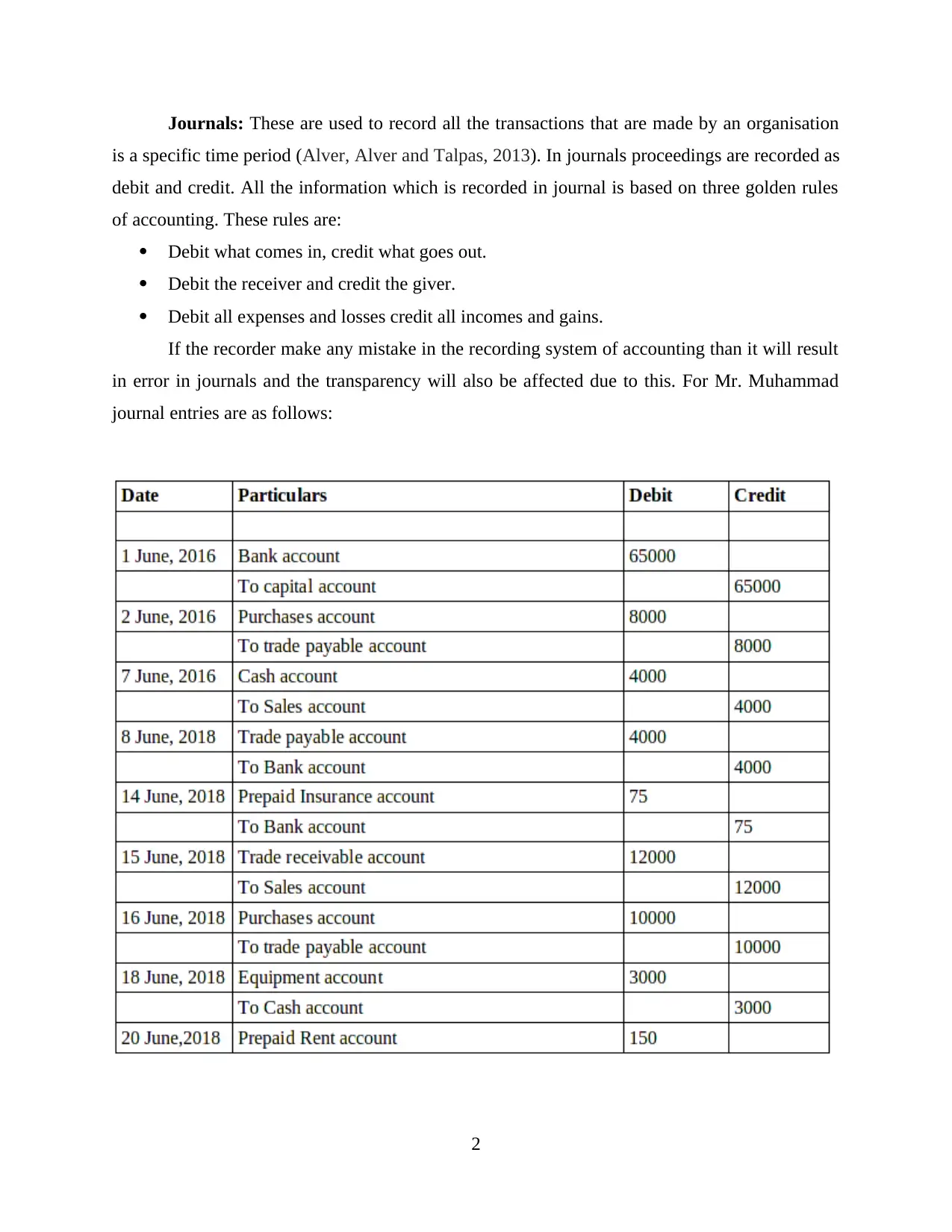
Journals: These are used to record all the transactions that are made by an organisation
is a specific time period (Alver, Alver and Talpas, 2013). In journals proceedings are recorded as
debit and credit. All the information which is recorded in journal is based on three golden rules
of accounting. These rules are:
Debit what comes in, credit what goes out.
Debit the receiver and credit the giver.
Debit all expenses and losses credit all incomes and gains.
If the recorder make any mistake in the recording system of accounting than it will result
in error in journals and the transparency will also be affected due to this. For Mr. Muhammad
journal entries are as follows:
2
is a specific time period (Alver, Alver and Talpas, 2013). In journals proceedings are recorded as
debit and credit. All the information which is recorded in journal is based on three golden rules
of accounting. These rules are:
Debit what comes in, credit what goes out.
Debit the receiver and credit the giver.
Debit all expenses and losses credit all incomes and gains.
If the recorder make any mistake in the recording system of accounting than it will result
in error in journals and the transparency will also be affected due to this. For Mr. Muhammad
journal entries are as follows:
2
Paraphrase This Document
Need a fresh take? Get an instant paraphrase of this document with our AI Paraphraser
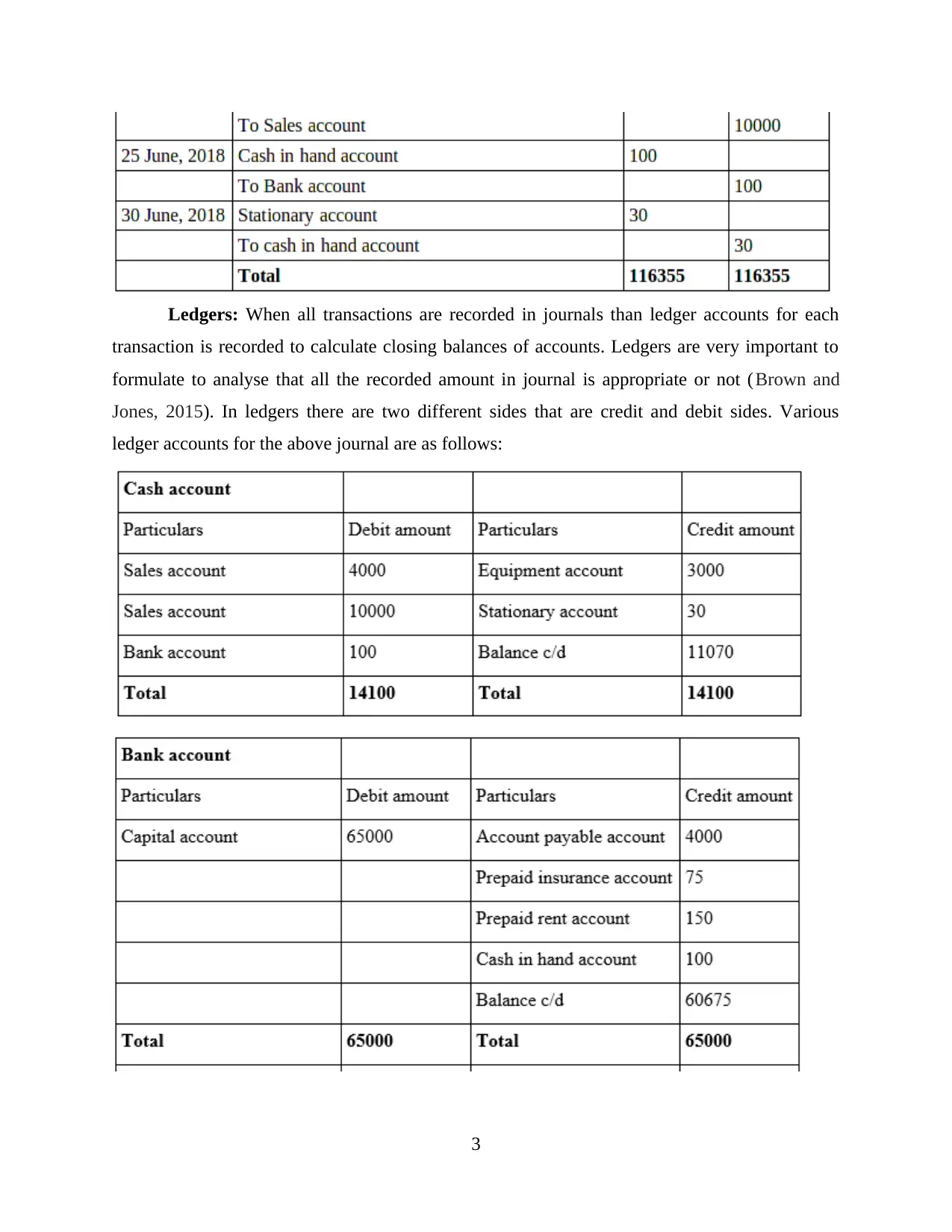
Ledgers: When all transactions are recorded in journals than ledger accounts for each
transaction is recorded to calculate closing balances of accounts. Ledgers are very important to
formulate to analyse that all the recorded amount in journal is appropriate or not (Brown and
Jones, 2015). In ledgers there are two different sides that are credit and debit sides. Various
ledger accounts for the above journal are as follows:
3
transaction is recorded to calculate closing balances of accounts. Ledgers are very important to
formulate to analyse that all the recorded amount in journal is appropriate or not (Brown and
Jones, 2015). In ledgers there are two different sides that are credit and debit sides. Various
ledger accounts for the above journal are as follows:
3
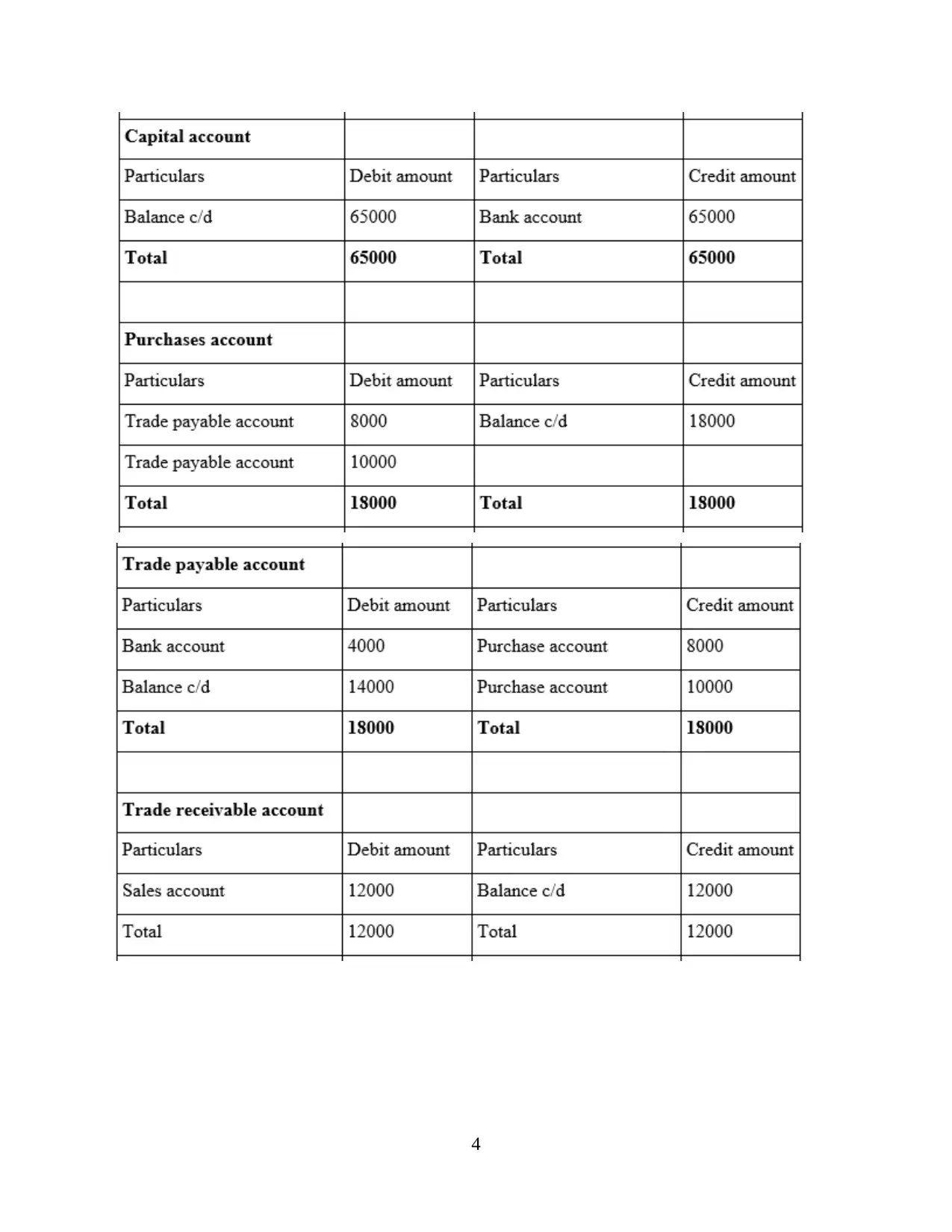
4
⊘ This is a preview!⊘
Do you want full access?
Subscribe today to unlock all pages.

Trusted by 1+ million students worldwide
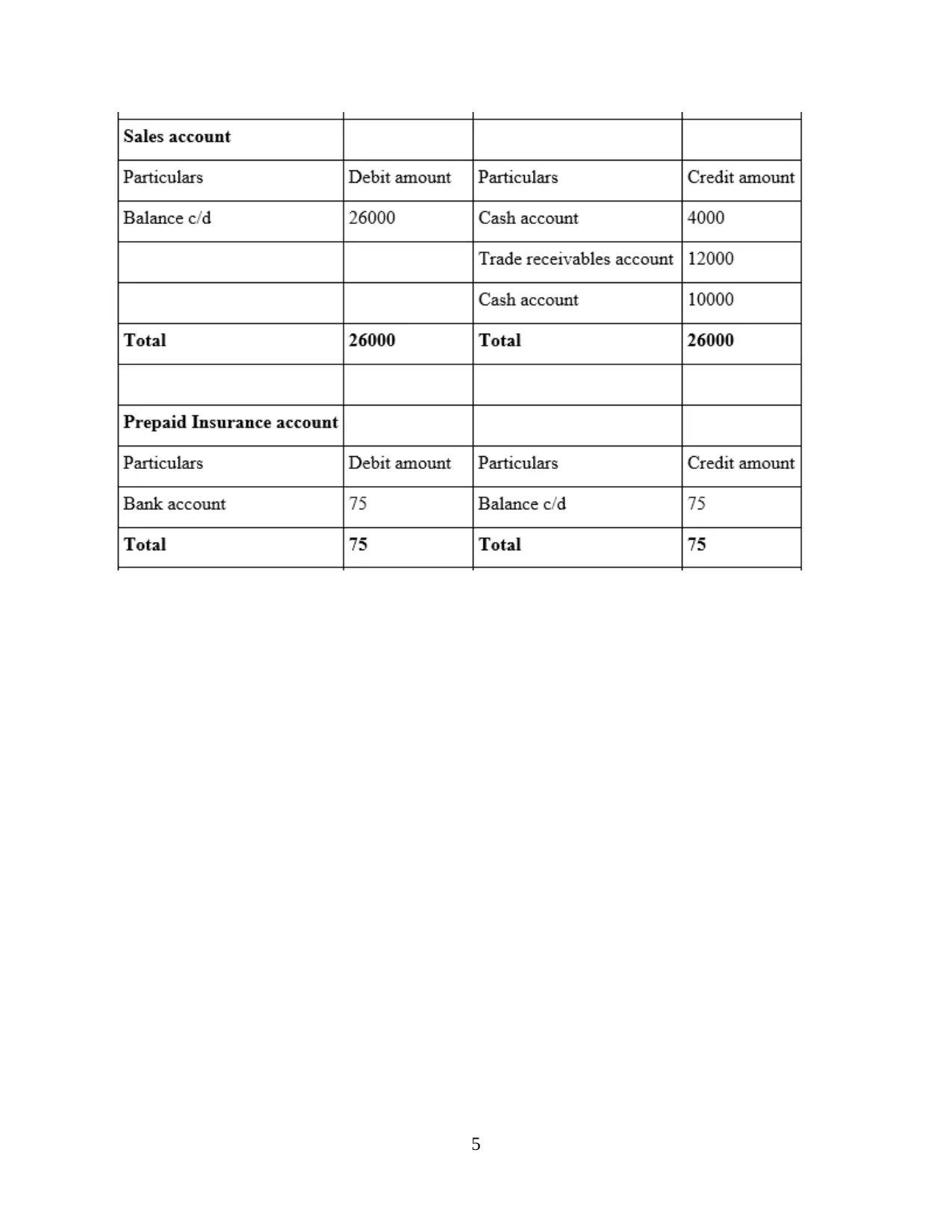
5
Paraphrase This Document
Need a fresh take? Get an instant paraphrase of this document with our AI Paraphraser
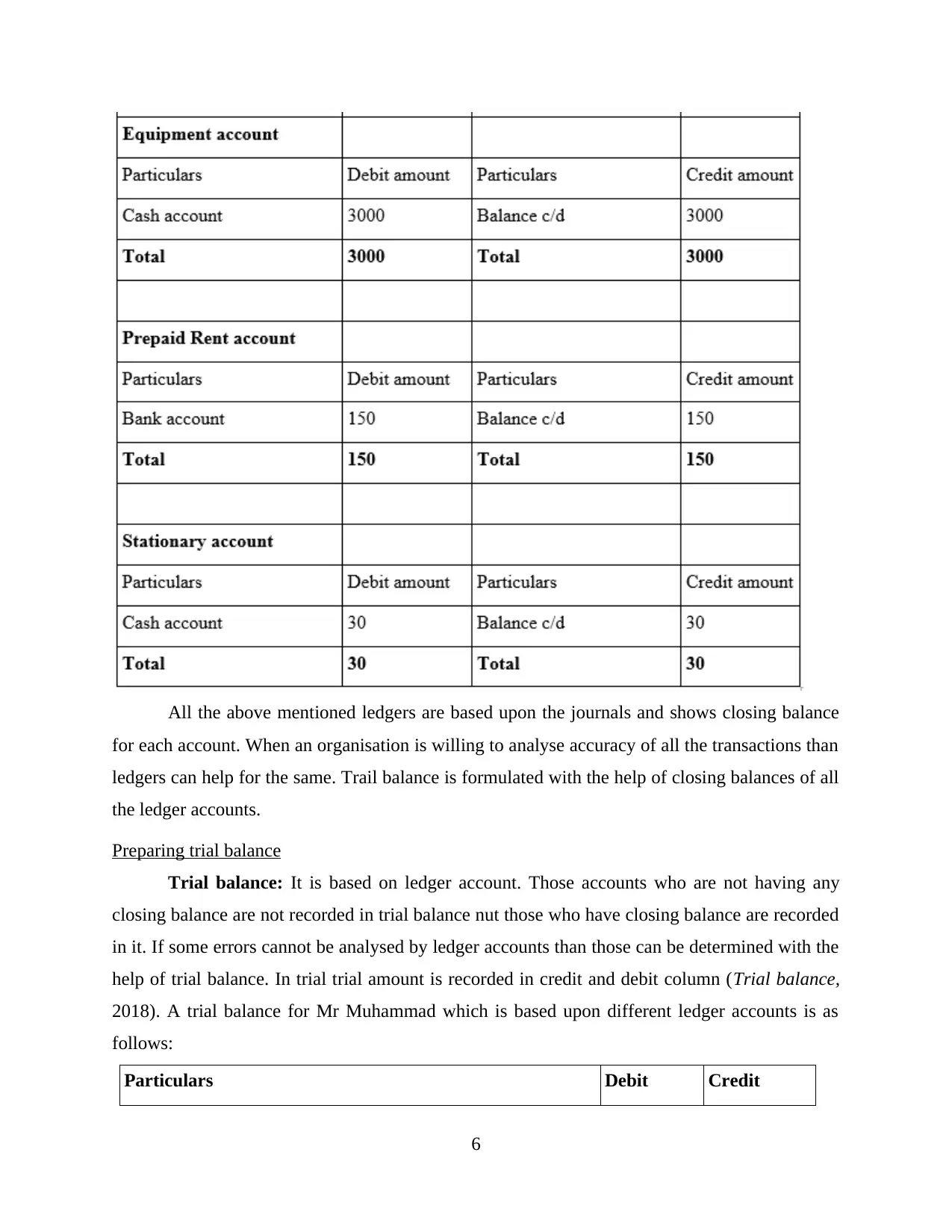
All the above mentioned ledgers are based upon the journals and shows closing balance
for each account. When an organisation is willing to analyse accuracy of all the transactions than
ledgers can help for the same. Trail balance is formulated with the help of closing balances of all
the ledger accounts.
Preparing trial balance
Trial balance: It is based on ledger account. Those accounts who are not having any
closing balance are not recorded in trial balance nut those who have closing balance are recorded
in it. If some errors cannot be analysed by ledger accounts than those can be determined with the
help of trial balance. In trial trial amount is recorded in credit and debit column (Trial balance,
2018). A trial balance for Mr Muhammad which is based upon different ledger accounts is as
follows:
Particulars Debit Credit
6
for each account. When an organisation is willing to analyse accuracy of all the transactions than
ledgers can help for the same. Trail balance is formulated with the help of closing balances of all
the ledger accounts.
Preparing trial balance
Trial balance: It is based on ledger account. Those accounts who are not having any
closing balance are not recorded in trial balance nut those who have closing balance are recorded
in it. If some errors cannot be analysed by ledger accounts than those can be determined with the
help of trial balance. In trial trial amount is recorded in credit and debit column (Trial balance,
2018). A trial balance for Mr Muhammad which is based upon different ledger accounts is as
follows:
Particulars Debit Credit
6
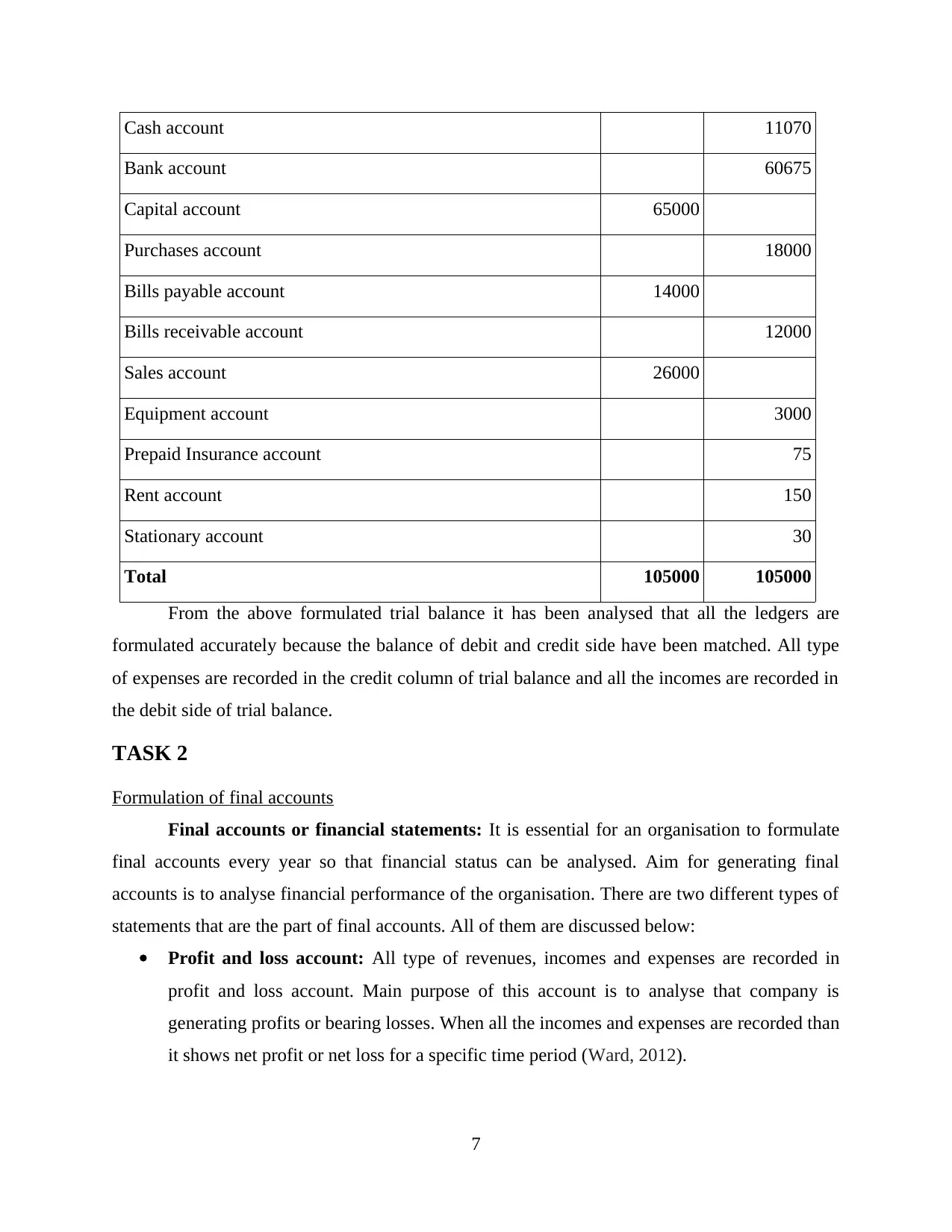
Cash account 11070
Bank account 60675
Capital account 65000
Purchases account 18000
Bills payable account 14000
Bills receivable account 12000
Sales account 26000
Equipment account 3000
Prepaid Insurance account 75
Rent account 150
Stationary account 30
Total 105000 105000
From the above formulated trial balance it has been analysed that all the ledgers are
formulated accurately because the balance of debit and credit side have been matched. All type
of expenses are recorded in the credit column of trial balance and all the incomes are recorded in
the debit side of trial balance.
TASK 2
Formulation of final accounts
Final accounts or financial statements: It is essential for an organisation to formulate
final accounts every year so that financial status can be analysed. Aim for generating final
accounts is to analyse financial performance of the organisation. There are two different types of
statements that are the part of final accounts. All of them are discussed below:
Profit and loss account: All type of revenues, incomes and expenses are recorded in
profit and loss account. Main purpose of this account is to analyse that company is
generating profits or bearing losses. When all the incomes and expenses are recorded than
it shows net profit or net loss for a specific time period (Ward, 2012).
7
Bank account 60675
Capital account 65000
Purchases account 18000
Bills payable account 14000
Bills receivable account 12000
Sales account 26000
Equipment account 3000
Prepaid Insurance account 75
Rent account 150
Stationary account 30
Total 105000 105000
From the above formulated trial balance it has been analysed that all the ledgers are
formulated accurately because the balance of debit and credit side have been matched. All type
of expenses are recorded in the credit column of trial balance and all the incomes are recorded in
the debit side of trial balance.
TASK 2
Formulation of final accounts
Final accounts or financial statements: It is essential for an organisation to formulate
final accounts every year so that financial status can be analysed. Aim for generating final
accounts is to analyse financial performance of the organisation. There are two different types of
statements that are the part of final accounts. All of them are discussed below:
Profit and loss account: All type of revenues, incomes and expenses are recorded in
profit and loss account. Main purpose of this account is to analyse that company is
generating profits or bearing losses. When all the incomes and expenses are recorded than
it shows net profit or net loss for a specific time period (Ward, 2012).
7
⊘ This is a preview!⊘
Do you want full access?
Subscribe today to unlock all pages.

Trusted by 1+ million students worldwide
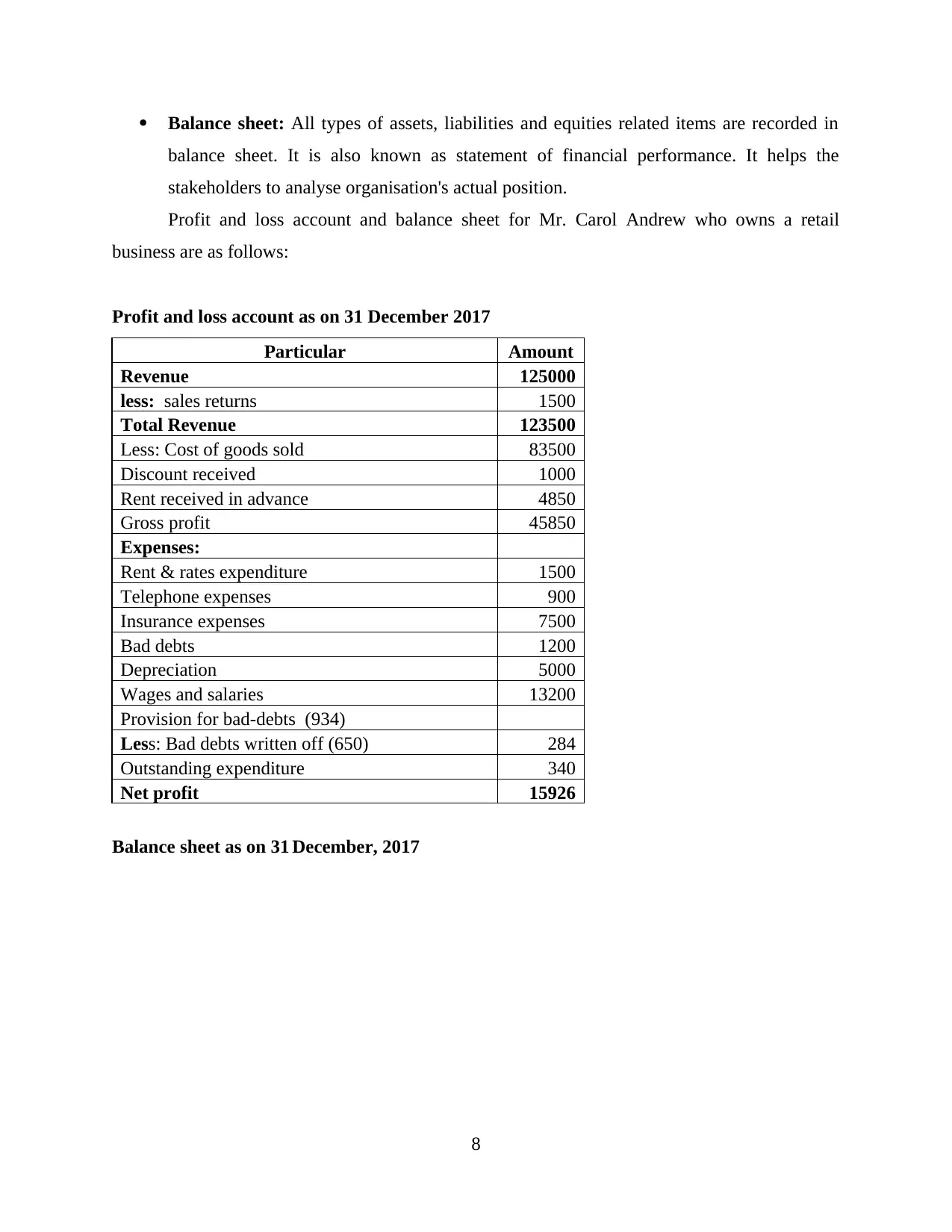
Balance sheet: All types of assets, liabilities and equities related items are recorded in
balance sheet. It is also known as statement of financial performance. It helps the
stakeholders to analyse organisation's actual position.
Profit and loss account and balance sheet for Mr. Carol Andrew who owns a retail
business are as follows:
Profit and loss account as on 31 December 2017
Particular Amount
Revenue 125000
less: sales returns 1500
Total Revenue 123500
Less: Cost of goods sold 83500
Discount received 1000
Rent received in advance 4850
Gross profit 45850
Expenses:
Rent & rates expenditure 1500
Telephone expenses 900
Insurance expenses 7500
Bad debts 1200
Depreciation 5000
Wages and salaries 13200
Provision for bad-debts (934)
Less: Bad debts written off (650) 284
Outstanding expenditure 340
Net profit 15926
Balance sheet as on 31 December, 2017
8
balance sheet. It is also known as statement of financial performance. It helps the
stakeholders to analyse organisation's actual position.
Profit and loss account and balance sheet for Mr. Carol Andrew who owns a retail
business are as follows:
Profit and loss account as on 31 December 2017
Particular Amount
Revenue 125000
less: sales returns 1500
Total Revenue 123500
Less: Cost of goods sold 83500
Discount received 1000
Rent received in advance 4850
Gross profit 45850
Expenses:
Rent & rates expenditure 1500
Telephone expenses 900
Insurance expenses 7500
Bad debts 1200
Depreciation 5000
Wages and salaries 13200
Provision for bad-debts (934)
Less: Bad debts written off (650) 284
Outstanding expenditure 340
Net profit 15926
Balance sheet as on 31 December, 2017
8
Paraphrase This Document
Need a fresh take? Get an instant paraphrase of this document with our AI Paraphraser
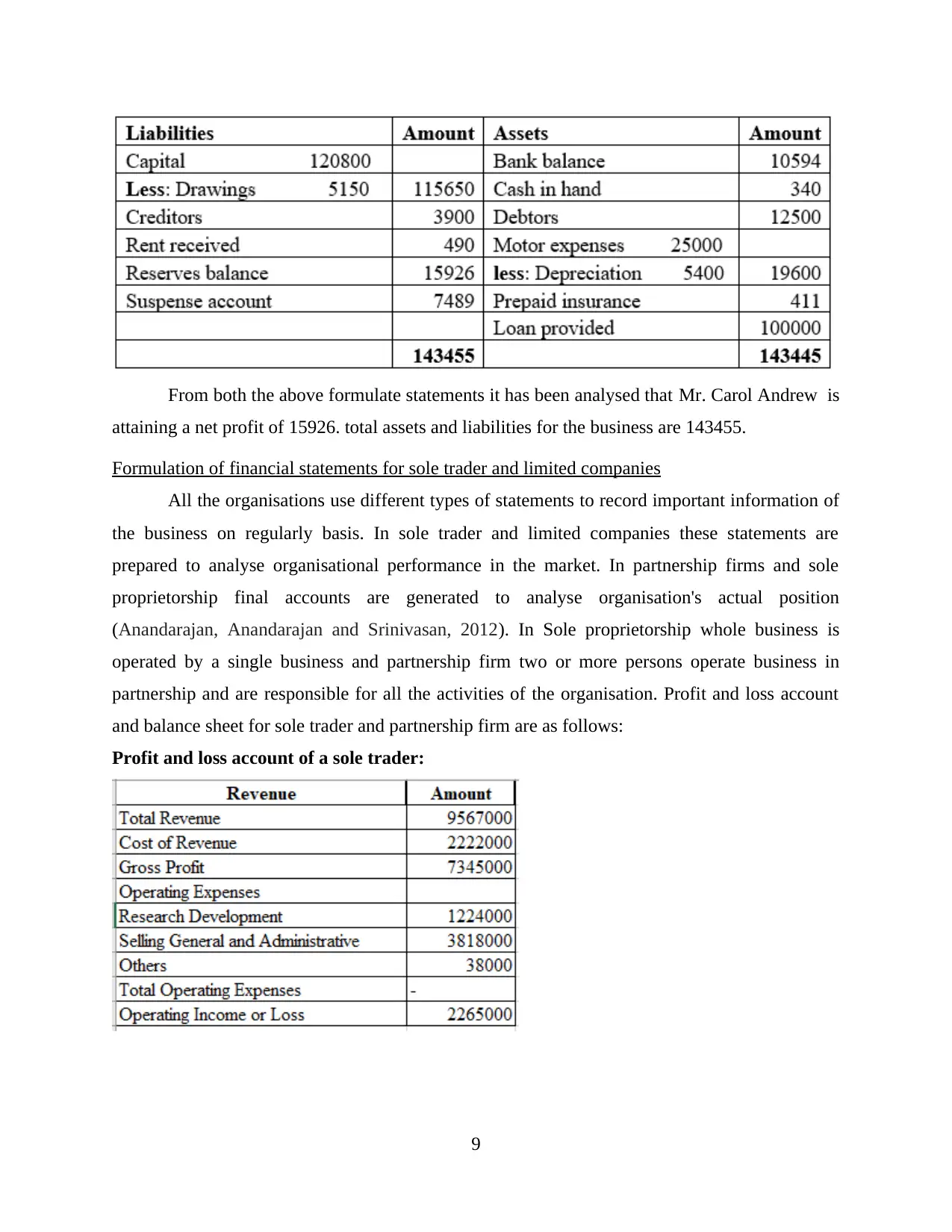
From both the above formulate statements it has been analysed that Mr. Carol Andrew is
attaining a net profit of 15926. total assets and liabilities for the business are 143455.
Formulation of financial statements for sole trader and limited companies
All the organisations use different types of statements to record important information of
the business on regularly basis. In sole trader and limited companies these statements are
prepared to analyse organisational performance in the market. In partnership firms and sole
proprietorship final accounts are generated to analyse organisation's actual position
(Anandarajan, Anandarajan and Srinivasan, 2012). In Sole proprietorship whole business is
operated by a single business and partnership firm two or more persons operate business in
partnership and are responsible for all the activities of the organisation. Profit and loss account
and balance sheet for sole trader and partnership firm are as follows:
Profit and loss account of a sole trader:
9
attaining a net profit of 15926. total assets and liabilities for the business are 143455.
Formulation of financial statements for sole trader and limited companies
All the organisations use different types of statements to record important information of
the business on regularly basis. In sole trader and limited companies these statements are
prepared to analyse organisational performance in the market. In partnership firms and sole
proprietorship final accounts are generated to analyse organisation's actual position
(Anandarajan, Anandarajan and Srinivasan, 2012). In Sole proprietorship whole business is
operated by a single business and partnership firm two or more persons operate business in
partnership and are responsible for all the activities of the organisation. Profit and loss account
and balance sheet for sole trader and partnership firm are as follows:
Profit and loss account of a sole trader:
9
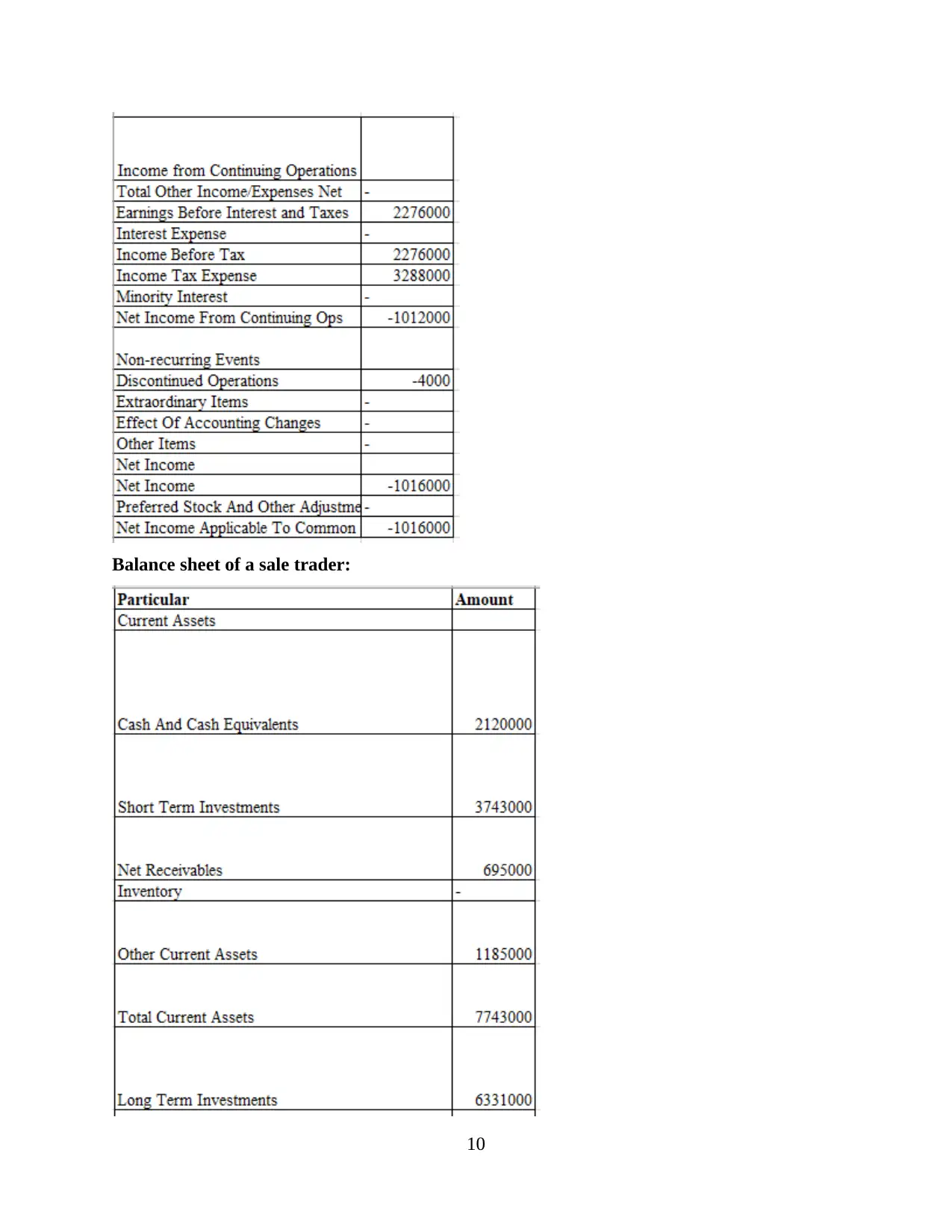
Balance sheet of a sale trader:
10
10
⊘ This is a preview!⊘
Do you want full access?
Subscribe today to unlock all pages.

Trusted by 1+ million students worldwide
1 out of 17
Related Documents
Your All-in-One AI-Powered Toolkit for Academic Success.
+13062052269
info@desklib.com
Available 24*7 on WhatsApp / Email
![[object Object]](/_next/static/media/star-bottom.7253800d.svg)
Unlock your academic potential
Copyright © 2020–2025 A2Z Services. All Rights Reserved. Developed and managed by ZUCOL.




